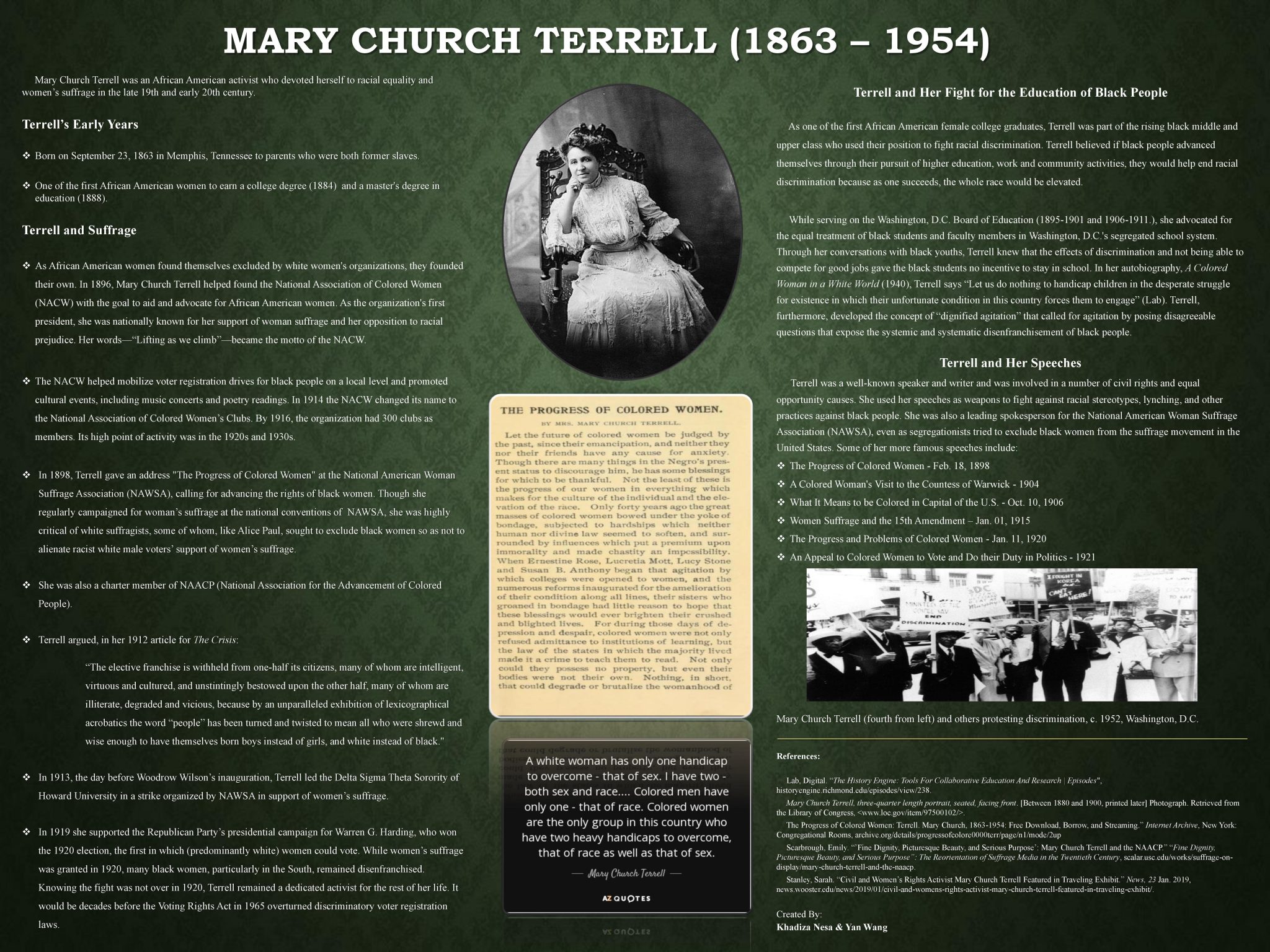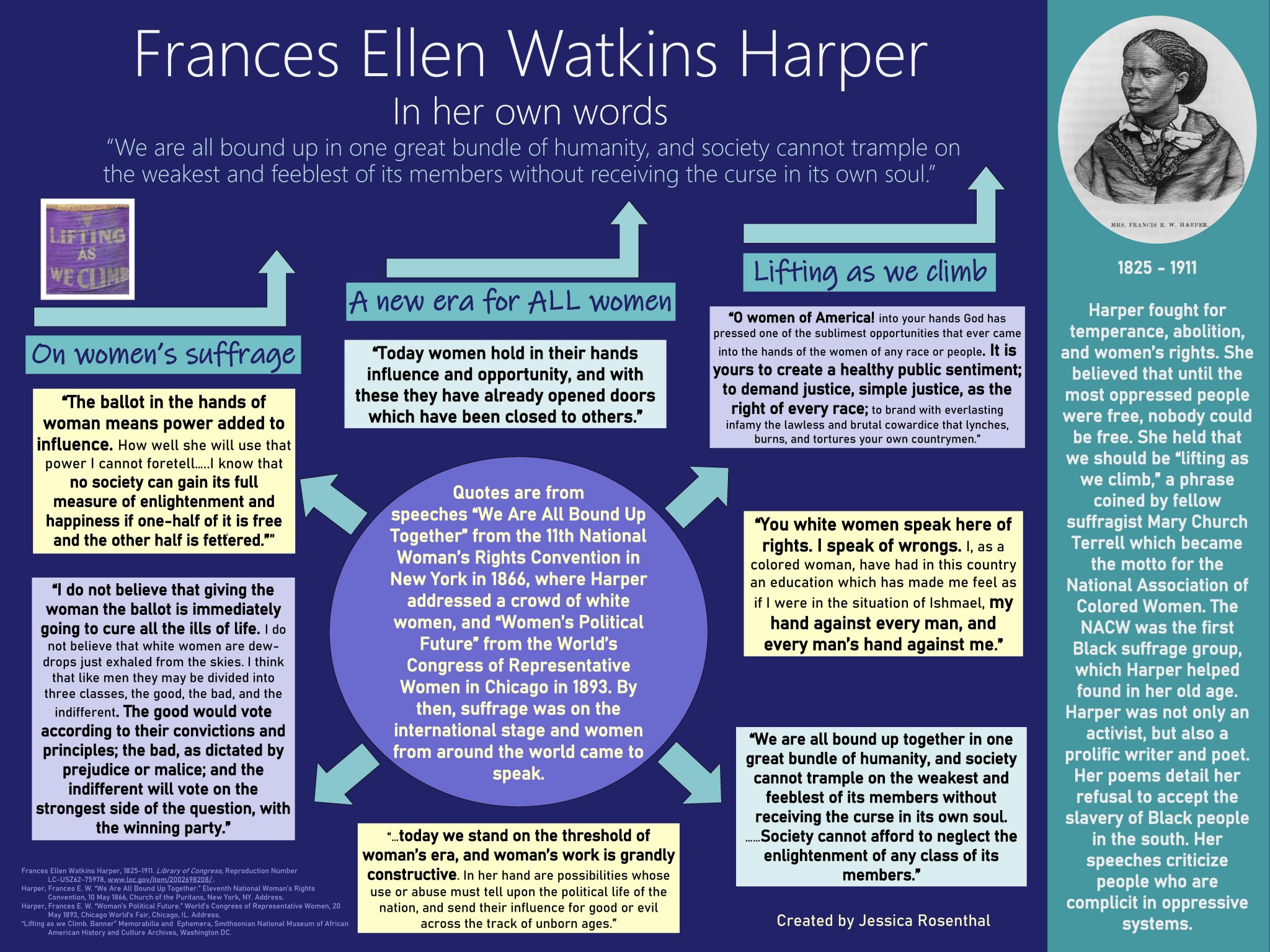The moment I signed up to work on the Women’s History Month exhibition, I knew the woman I wanted to highlight immediately. Unlike most of the other women in this exhibition, my figure is not really considered to be overlooked. She is one of the most popular abolitionists and suffragists of color in history. She was a former slave, who was most notably the speaker of the impromptu speech, Ain’t I A Woman which was Delivered during the Women’s Rights Convention in 1851 at the Old Stone Church in Akron, Ohio.
I centered my poster around Sojourner Truth, who, in reality, is a popular figure in both black history and women’s history, but I felt it was important for people to understand why. Sojourner Truth’s story is a compelling one filled with courage. Like many people of color from her time, she was not allowed the opportunity to have an education. She never learned to read or write, and yet, she never let that hold her back, and she never let her voice go unheard.
Sojourner Truth’s story is an important one. It reminds us all that no matter what challenges we may go through in life, we come out the other side a stronger person than when we went in. Her story also shows us the importance and the value of speaking your mind, even when most of the country does not agree with you. In life, it is okay to be wrong, but it is never okay to not speak up for something that negatively affects you or your people. Those are values that I hold dear, and I hope you will hold those values dear to you as well.
I have decided to highlight Gertrude Bustill Mossell in my research because she is from a family of status unlike most women of color in the women’s suffrage movement. I enjoyed learning how Mossell’s family members inspired and empowered her to become an outspoken journalist. Yet, despite being a member of a prominent and supportive family, her work was undermined in comparison to her white female writers counterparts.
Until I read Mossell’s “A Lofty Study,” I have credited the idea of women’s need for a personal space to self-reflect to Virginia Wolf’s who speaks of this need in her essay “A Room of One’s Own.” After reading Mossell’s “A Lofty Study,” I started to wonder if there were additional ideas she put forth that was not given due credit for.
Moreover, it was interesting to see that Mossell had a supportive husband with whom she worked in close collaboration. Joining efforts, they were able to build a hospital that did not only cure patients, but also was a school to train African American nurses and doctors.
Mossell’s accomplishments speak to the importance of having a supportive family in order for a person to thrive and make a difference. Most importantly, for those of us who have not received much family support, the message is that we ought to reflect on our relationships with our family, be more compassionate with those around us, and help them and ourselves become true change makers.
For the Women’s History Month exhibition, I knew I wanted to create a poster that focused on the words of an influential but overlooked figure in the fight for women’s equality. The history of suffrage is far too narrowly focused on the white women who were involved in the fight, and almost completely ignores women of color who fought hard not only for women’s rights, but also for the rights of other oppressed peoples. I chose to center my poster on Frances Ellen Watkins Harper. Harper was an abolitionist, suffragist, novelist, poet, and lecturer. She was a prolific writer and speaker who left much of her legacy behind in her own words. It was important to me to reflect her voice rather than giving my own take on her life. Harper’s words remind us that there is more to history and justice than the most repeated stories, and that we should always critique one another while fighting to uplift all oppressed people. Frances Harper reminds us how easy it can be to overlook oppression and unfairness when we are not directly affected by it. She shows us that it is possible to be faced with oppression on more than one level and that, no matter your position in society, it is important to speak out when we see injustice happening.
 Created by: Khadiza Nesa and Yan Wang.
Created by: Khadiza Nesa and Yan Wang.
For the exhibition of Women Herstory Month, we chose to make a poster about Mary Church Terrell because of her inspiring leadership. She was one of the first African American women to earn a college degree. She was a teacher, a speaker, and a national activist.
After hearing the tragic news that her close friend had been lynched, Terrell became a social activist in 1892 to fight for the rights of African Americans. That year, Terrell worked in collaboration with Fredrick Douglass, but their appeals to President Benjamin Harrison failed to produce a public condemnation of lynching; therefore, Terrell established the Colored Women’s League in Washington to address social problems facing black communities.
In 1896, Terrell worked with Ida Bell Wells, Harriet Tubman, Margaret Murray Washington, and Frances E. W. Harper to establish the National Association of Colored Women (NACW). She became the first president of this organization. Under her leadership, this organization worked to stop discrimination and carry out educational and social reform in African American communities to support and empower African American women. The organization’s motto was “Lifting as we Climb” that reflected its goal to elevate African American women to leadership positions, such as entrepreneurs. The leaders of the NACW believed that once African American women are educated to hold leading roles, the whole Black community will rise up.
Between the years 1896 and 1902, Terrell became a well-known writer and speaker in the US and overseas. Her last act as an activist was to lead a successful three-year struggle against segregation in hotels and public eating places in the nation’s capital. Her autobiography, “A Colored Woman in a White World,” appeared in 1940. Our poster explores her support of the women’s suffrage movement in a time where segregationists tried to exclude black women from the cause.


